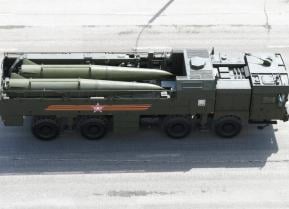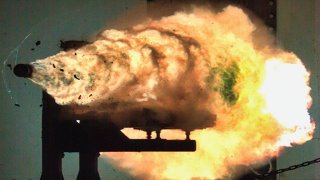Why Doesn't the U.S. Military Have a Railgun Weapon?
Railgun weapons were supposed to be the future of the U.S. military. So why doesn't America have any systems built?
Japan Tested a Railgun – What Happened to U.S. Railgun Efforts? In October 2023, the Japanese Ministry of Defense's Acquisition, Technology & Logistics Agency (ATLA) announced that it had accomplished a ship-board firing test of a railgun for the first time in the world. The test was conducted with the cooperation of the Japan Maritime Self-Defense Force (JMSDF).
ATLA further released video footage of the test launch on X – the social media platform formerly known as Twitter. That footage highlighted the still-in-development weapon firing a number of rounds into the ocean.
"#ATLA has accomplished ship-board firing test of railgun first time in the world with the cooperation of the JMSDF. To protect vessels against air-threats and surface-threats by high-speed bullets, ATLA strongly promotes early deployment of railgun technology," ATLA noted in its post.
Tokyo has been engaged in developing a railgun since 2015, with the aim of being able to stop incoming missiles – including potential hypersonic missiles – that are fired at the island nation. The aim has been to mount such a weapon on a warship.
A 2016 demonstration of a railgun had a projectile reach a speed of approximately 4,470 mph, or 5.8 times the speed of sound.
What Exactly is a Railgun?
The concept may seem like something straight out of science fiction: it is a weapon that could utilize a large circuit to launch a projectile far further and at exceeding greater speeds than one launched by a chemical reaction.
There have been real-world efforts to develop such a platform, with the earliest attempts dating back more than a century. Yet most have failed – suggesting it is easier for science fiction writers to dream up such fantastic weapons than it is for engineers to actually make them a reality.
The first effort was led by Andre Louis Octave Fauchon-Villeplee, who created a simple electric cannon, which caught the attention of the French military, which was seeking a weapon that could rival such long-range cannons as Germany's so-called "Paris Gun."
Under the direction of the Director of Inventions at the French Ministry of Armaments in 1918, Fauchon-Villeplee was charged with developing a 30 to 50 mm electricannon based on his simple design. While it might not seem revolutionary today for the French military to be so forward-thinking, it should be remembered that at the start of the war, its uniforms and tactics were little changed from that of a generation earlier.
Yet, France also saw the need to modernize and underwent a number of wartime reforms. This included the use of the first infantry combat helmet, but France soon followed its British ally's lead to develop tanks.
Likewise, Germany developed zeppelins to bomb England and later developed some of the earliest heavy bombers. Therefore it is almost surprising that one of the countries didn't somehow develop a successful railgun, but the simple fact is that the war ended before Fauchon-Villeplee's experiments were able to progress very far.
Moreover, he was simply ahead of his time.
A Century of Progress But Still No Railgun
In the more than a century since the First World War, we've seen military hardware advance by leaps and bounds. We have jet aircraft, nuclear-powered warships, and drones.
So why not a railgun?
At issue is the energy required. There certainly exists the basic technology – which includes that large (very large) power source, a pair of parallel rails, and a moving armature. The concept itself is rather simple, but since it was first envisioned, the basic problem has been one of obtaining enough power to actually launch a projectile in a controlled and reliable manner. A railgun could require millions of amps to create a magnetic field required to launch the projectile.
A nuclear reactor could provide the power, but that's just part of the problem.
The rails, which need to be of a conductive metal such as copper, would need to be four to thirty feet long or longer, which is why railguns could be well-suited to a warship – and why despite what video games may suggest, we likely won't see rifle-sized railgruns.
There is the issue of resistive heat, which can damage the surface of the rails. Heat has been a problem with machine guns since their invention and an early solution was to water cool the barrel, while later the best option was to swap out the barrel and maintain fire discipline. Cooling options are being explored, but a weapon that can’t be repeatedly fired without damaging the system isn’t something any military is likely to adopt.
The final problem is that the currents can also create serious wear and tear—meaning many prototypes will break after just a few uses.
The U.S. Navy's Efforts
Over the past decade, the United States Navy invested upwards of $500 million into its electromagnetic railgun (EMRG) program. The goal of the project was to develop a weapon that could be capable of firing projectiles at hypersonic speeds of 4,500mph or more. Because of the high speed, mass, and kinetic energy, the projectile wouldn't even need to contain explosives to inflict damage.
Yet, after years of troubled development, the much-hyped supergun has made only limited progress and is now largely stuck in the research and development stage. And it hasn't been for lack of effort, or as noted money.
The U.S. Navy has sought to address the issues of energy, heat, and wear to the platform, but so far hasn't been able to find the perfect solution. Perhaps the Japanese military will have better luck.
Author Experience and Expertise
Peter Suciu is a Michigan-based writer. He has contributed to more than four dozen magazines, newspapers, and websites with over 3,200 published pieces over a twenty-year career in journalism. He regularly writes about military hardware, firearms history, cybersecurity, politics, and international affairs. Peter is also a Contributing Writer for Forbes and Clearance Jobs. You can follow him on Twitter: @PeterSuciu.


